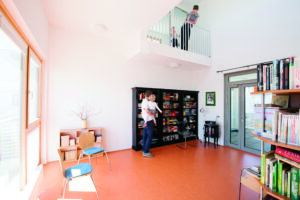Europan – Wien, Austria

Oase 22
Just after the competition, the team entered in a discussion phase with several actors included Wien Holding, the head of the housing cooperative GESIBA, the head of the district and Europan secretary. They had to sharpen their ideas and their concepts. It was also discussed whether the team should consider rezoning the area but then they decided that through a slight translation of the urban plan without really losing a lot of the qualities, they could avoid this time consuming process. At the end of this first phase it was decided that the project should be realized within the framework of the Wienese Subsidised Housing, which meant that the site should be divided into three smaller parts and thar another competition called Bauträgerwettbewerb should take a place. The team was invited both to build one part of this project and to contribute to elaborate the competition brief. In order to pursue their idea from Europan competition, the team involved additional experts for landscape architecture and for participation and all together they formulated additional rules and regulations for this competition brief, which should complement the existing zoning. These rules concerned the configutation of the whole project, but also the character of the garden courtyard, the rooftop route, several main common spaces in each project part and thar should be included in each project a participative activation process.
Studio uek worked on this specific element of urban porosity, on connecting points between the outside road, the surroundings and the inside world of the housing project.

Two Austrian teams were selected to build the two other parts of the area. The first one (ARGE Köb&Pollak / Alexander Schmoeger) on the North side worked on experimental housing providing apartments from a very small size like 30m2 up to big shared apartments. The second team (goya ZT GmbH), in the South part, focused on young and urban housing with a lot of sports and leisure facilities inside the housing project. Studio uek built 171 housing (of which 30 are sheltered housing) + a geriatric day centre. The three built parts have some common spaces dedicated, for some of them, to support the small community of the building and for some other, to offer possibilities to inhabitants of the whole project (like the “play and celebration space” in the studio uek part). A roof-top-route links the three built parts offering also collective spaces (like tenants flowerbeds, glass house, summer kitchen…)
The participative activation process allowed inhabitants to define the programs for smaller common spaces and they were also involved in the management of the flowebeds / garden on the roof.


Location
Oase 22, Vienna, Austria
Client
GESIBA (section 1) / BUWOG (Section 2) / ÖSW (section 3)
Architects
ex Studio uek- Theresa Krenn, Katharina Urbanek, Benni Eder, Julia Wieger, Stefanie Nolz- (section 1) / ARGEbKöb&Pollak + Alexander Schmoeger (section 2) / goya ZT (section 3)
Program
171 housing including 30 sheltered housing + geriatric centre + common spaces / services (section 1) / 64 apartments including 3 shared ones + common spaces /services (section 2 ) / 84 apartments for young people+ common spaces/ services (section 3)
Surface
13.595 m2 (section 1) / 5.345 m2 8section 2) / 6.934 m2 (section 3)
Completed
2012/ 2013
More information:
- https://www.europan-europe.eu/en/project-and-processes/swobodas-go-neustadlau
- https://www.studioederkrenn.com/?cat=1
- https://www.studiourbanek.at/project/oase22/
Europan is shaping the idea of a Europe of the young architectural, urban and landscape design by federating European countries around competitions of urban-architectural projects and professional exchanges in these fields of design. Europan does so within the framework of the sustainable city and the qualitative changes that it operates, and taking into consideration the economy of resources, new mobilities and the enhancement of natural spaces.
